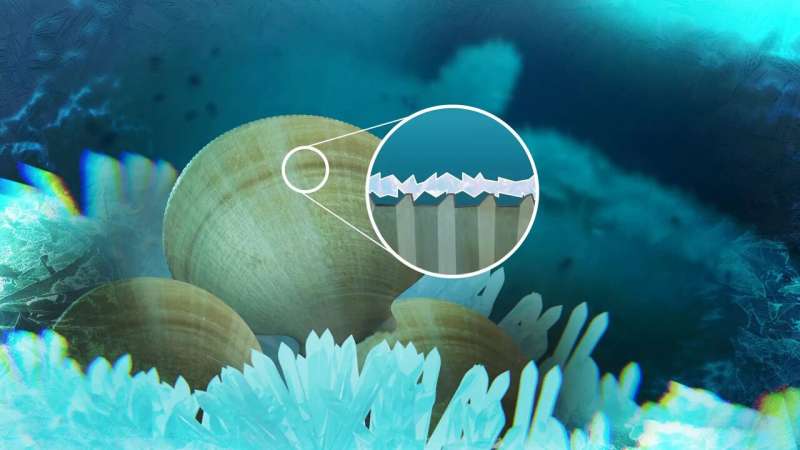
Due to a regular surface structure on the mussel "Adamussium colbecki" ice adheres to it only very weakly and can be easily washed away by currents. Credit: Max Planck Institute for Polymer Research
Posted on 03/03/2022 11:42:54 AM PST by LibWhacker

Due to a regular surface structure on the mussel "Adamussium colbecki" ice adheres to it only very weakly and can be easily washed away by currents. Credit: Max Planck Institute for Polymer Research
Antarctic waters have conditions in which objects and living creatures can freeze even under water. This is a major problem for marine travel in polar regions. So-called supercooled water has a temperature just below the freezing point. Due to the high salt content, water in Antarctica has a freezing point of about -1.9 °C, but is about 0.05 °C colder. The smallest disturbances such as grains of sand or surfaces can cause this supercooled water to freeze—with sometimes fatal consequences for creatures that cannot survive frozen.
The Antarctic scallop "Adamussium colbecki" resists this, as chemist Konrad Meister knows. Meister is a professor at the University of Alaska and heads a research group in Mischa Bonn's department at the Max Planck Institute for Polymer Research (MPI-P) in Mainz. During an expedition in Antarctica, divers drew his attention to the scallop with the efficient ice protection mechanism. "Our divers reported that they had never observed large-scale ice on the surface of this native scallop species," Meister says.
The international research team, consisting of members of several MPI-P research groups as well as the University of Oregon, suspects that the scallop species developed a special surface structure during evolution that protects it from icing. While scallops in warmer regions have disordered or smooth shell surfaces, the Antarctic species has a microscopic, very regular structure.
The microscope reveals small ridges that run in a radiating pattern on their shell. These ridges ensure that water freezes preferentially there. If the freezing process continues, a continuous layer of ice forms, resting only on the ridges. Due to the low adhesion between ice and shell, the smallest underwater flow can therefore wash off the ice again and the scallop does not freeze.
In addition to microscope studies, the research team also conducted icing experiments with the Antarctic and with a scallop from warmer regions. It was found that far less force is needed to remove the ice layer on the Antarctic scallop than for the other species.
"It is exciting how evolution has obviously given this scallop an advantage," says Konrad Meister. "New technological applications based on the principle of bionics are conceivable from the knowledge of the ice-free shell. For example, non-icing surfaces could be highly interesting for polar shipping."
Me too, buddy. Veeery hungry!
Bon appetite!
Makes sense the homeowners cleaned up and municipalities still let it spew.
The article states: “Due to the low adhesion between ice and shell, the smallest underwater flow can therefore wash off the ice again and the scallop does not freeze.”
That clearly says “the scallop does not freeze”. For your point to be accurate, it should state: “the scallop does not become covered with ice.” I believe your interpretation is probably correct and that the scallop likely has a lower freezing point than the water temperature. I was pointing out that the article is poorly written, or should have included more information about the temperature at which the scallop will actually freeze.
Shellfish on piling absorb the creosote they pilings are soaked in. HC flushes over a 7 year period.
Unless Victoria, BC has made a major investment in sewage treatment recently, they dump raw sewage directly into the Straits.
Disclaimer: Opinions posted on Free Republic are those of the individual posters and do not necessarily represent the opinion of Free Republic or its management. All materials posted herein are protected by copyright law and the exemption for fair use of copyrighted works.